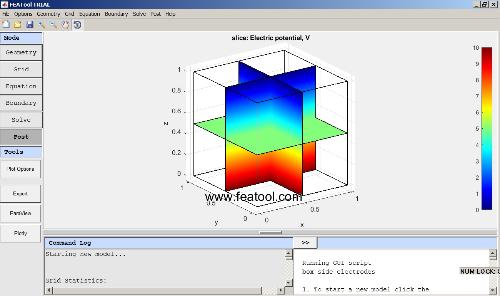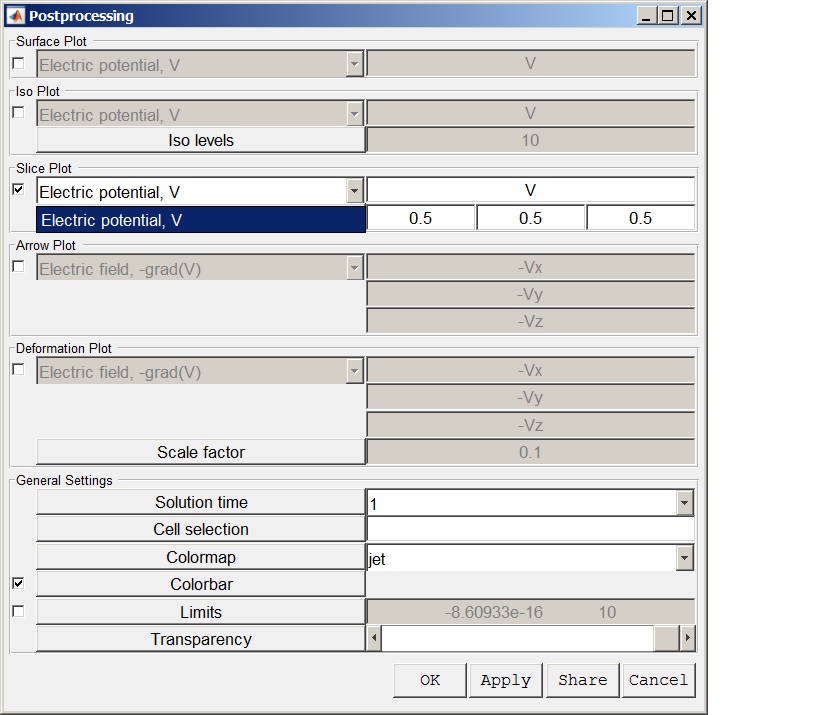DC Conduction Plot Options
|
I created a simple DC Conduction model consisting of a cubic material with 10V on one face and 0V/Gnd on the opposite face. The cut plane plots of Voltage(x,y,z) were easily specified and produced:
 However, I have been unable to specify an E Field (dV/dt) cut plane plot using the plot settings window:  Is this an example of limited functionality of the free/trial version? Thanks for any comments, -Randal |
Re: DC Conduction Plot Options
|
Administrator
|
Dear Randal,
Thank you for trying FEATool. You can plot the magnitude of the electric field by entering the corresponding expression "sqrt(Vx^2+Vy^2+Vz^2)" in right side edit field next to the 'Slice Plot' drop-down box. The expression simply has not been predefined. If you are interested in the time variation dV/dt this quantitiy is currently only available internally to the solvers, as it is not explicitly computed. However, you could also export you solution to Matlab and perform the differentiation manually between time steps (solution vectors).
|
|
Thanks for your prompt reply. It was a great help, but I have a few quetions ... but let me correct my original post :-(
What I meant was not (dV/dt) but grad(V) ... after all, it is a "DC" conduction problem ... the time-train left the station at the get-go! ... Thank you for making it available! I am a retired software/electrical engineer seek an FEA tool for study/analysis of Electric Shock Drowning (If you are interested: www.electricshockdrowning.org & www.webmd.com/first-aid/news/20190722/electric-shock-drowning-silent-killer) The “container” or “air box” for simulating this is water* (pool, lake, river, ocean, etc.) I will be attempting to place a body of human tissue material in this medium and study the E Field and current density in and around the body produced by electric currents leaking into the water from boats, boat lifts, and other electrical wiring leaks/faults near the water. As a private not-for-profit individual, I cannot afford the likes of many of the available tools. I have worked through a trial of QuickField, and ElecNet, and am in the midst of COMSOL. I am hoping that FEATool will be suitable - the $245 non-commercial license option is what I am considering. I hadn't realized expressions could be customized. WHERE IS THE EXPRESSION syntax documented? I am looking forward to learning more of FEATool's capabilities. I there other documentation other than: https://www.featool.com/doc ? BTW, I am assuming that FEATool utilizes a virtual address space that is greater than 32-bits. Correct? Kind regards, Randal |
Re: DC Conduction Plot Options
|
Administrator
|
Please find answers to your questions below.
Thank you for sharing your modeling interest and application, I was not aware that such a phenomena occurred at all. I believe this should be possible to simulate for FEATool if the geometry doesn't involve too much details. In addition to some model tutorials which make us of this feature, you can find more information on valid FEATool expression syntax from the links below: FEATool Multiphysics Documentation > Physics Modes > Coefficients and Expressions Modeling with Non-constant Coefficients in FEATool Multiphysics Adding Multiphysics Equations and Using Complex Expressions with the exception of coefficients involving the weak PDE formulation (ex. "ux_x") which can only be used in equations, expressions can be used in subdomain, boundary, and point coefficients as well as in postprocessing evaluation. The idea is that you essentially should be able to express what you want just as you would write it on paper. There are also technical articles one the FEATool website/blog https://www.featool.com/articles, and a FAQ https://www.featool.com/faq. The idea, although not very successful so far, is also that this forum would be a way for user's to help each other. This depends on the runtime which currently is tied to Matlab, and if I recall Matlab is more or less only available in 64-bit versions for the last 10 releases or so. That said, as Matlab is not very efficient working with very large models will be very slow, so currently FEATool is better suited for small to medium size models. |
|
Thank-you for the additional references.
Will these inefficiencies show up in the trial version in the same manner and to the same extent as those of the upgraded version.? I would like to understand (and see first hand) just how these limitations may affect my application. Can you tell me which of the steps - Geometry Grid Equation Boundary Solve Post - use these Matlab libs? How does this efficiency tend to scale with processor speed, cores, and RAM? I am currently using 2.4 GHz i5 dual core 8Gb RAM. Do you have any benchmarks/rules-of-thumb regarding, say, the number of mesh nodes? [BTW, as I explore post processing, I have a few more questions. Would you prefer that I start another thread?] -Randal |
Re: DC Conduction Plot Options
|
Administrator
|
Yes, the performance will be identical. The trial version simply disables some advanced features. The whole toolbox is currently built on Matlab functionality, however some steps make use of external software such as grid generation with Gridgen2D, Gmsh, and Triangle, as well as specialized solvers such as OpenFOAM, FEniCS, and SU2. The main inefficiency you can see is when you import a large CAD model and rendering and graphics will be very slow due to a large polygon count. That system should be quite fine, although if you really want to simulate large 3D models 16 GB ram is better. Hard to say as it all depends on space dimension, mesh type, finite element space etc. I would simply recommend you to try and see if your model works. Yes, please do if you think the question belongs to a new topic. |
Just to clarify ... I would assume that the high polygon count would have the same effect if the large model were built within FEATool rather than being imported. Correct? -Randal |
Re: DC Conduction Plot Options
|
Administrator
|
Yes, that is correct. It is the absolute polygon count that will be the issue and not where it comes from. |
«
Return to Basic Use
|
1 view|%1 views
| Free forum by Nabble | Edit this page |

